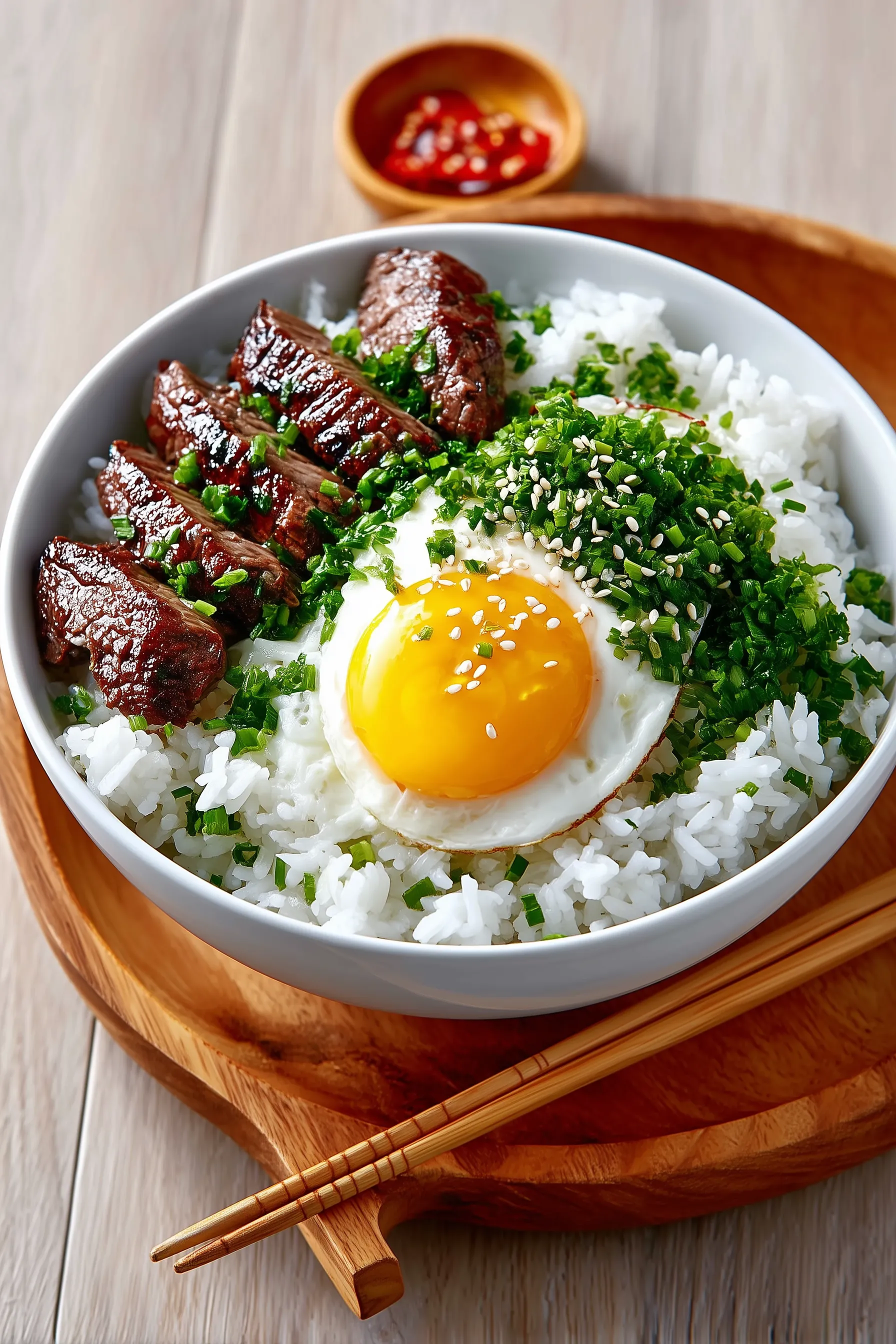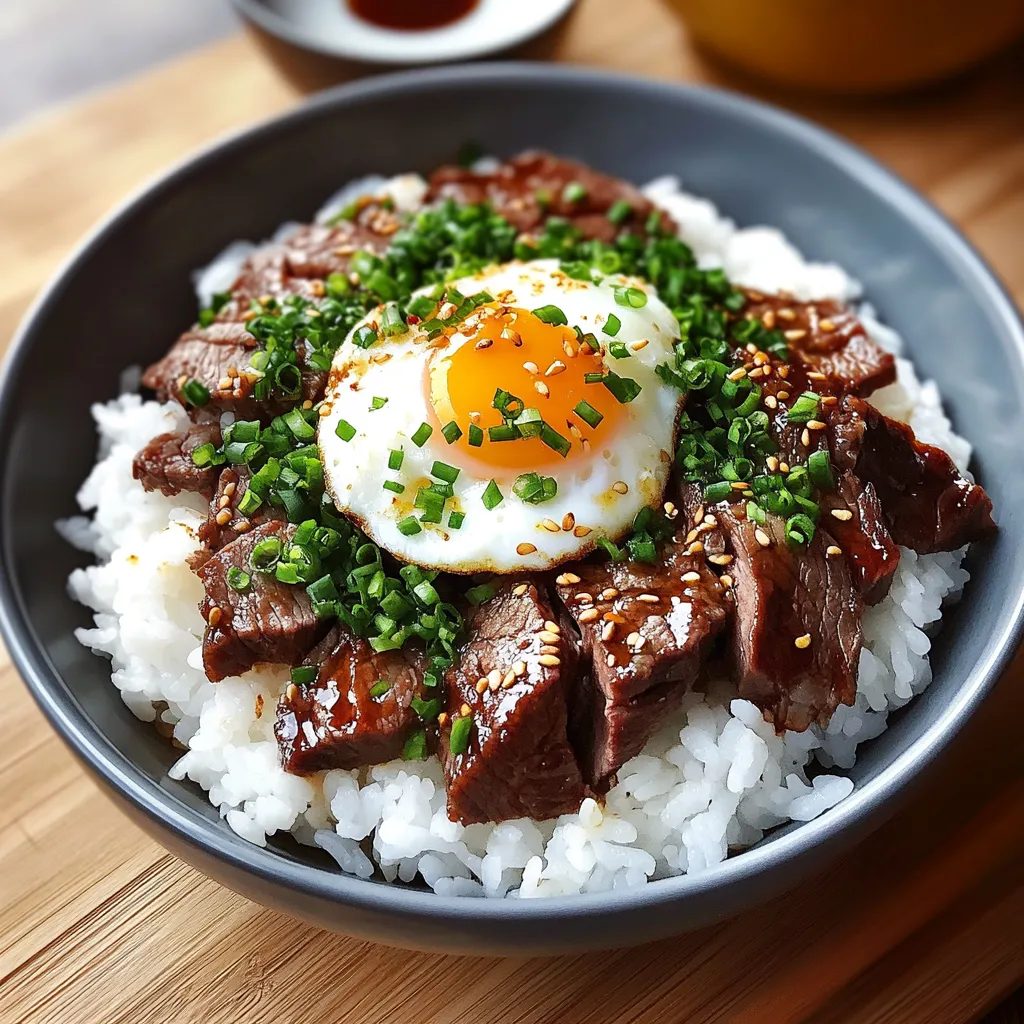 Save
Save
Japanese beef donburi with a poached egg is one of those weeknight dinners that feels extra special without a lot of time or fuss. Richly marinated beef simmers with delicate onions and nestles on steamy rice under a wobbly egg. I fell in love with this dish after a Tokyo trip and now make it for cozy nights when a bit of comfort is in order
Ingredients
- Japanese short-grain rice: Gives that classic sticky yet tender base Choose pearly grains that clump gently when pressed
- Beef sirloin or ribeye: Thin slices mean quick cooking so the meat stays buttery fresh Always look for a nice marbled cut
- Egg: Preferably soft-boiled or poached The creamy yolk creates that signature donburi sauce texture Use eggs as fresh as possible for poaching
- Green onions or chives: For a gentle sharpness and color Seek vibrant bunches with no wilting
- Sesame seeds: Optional but add a nutty aroma Use toasted seeds for deeper flavor
- Soy sauce: Core to authentic gyudon flavor Go for naturally brewed low sodium if you like
- Mirin: Sweet rice wine for subtle sweetness Look for bottles with short ingredient lists
- Sake: Balances savory and sweet with a gentle edge
- Sugar: Rounds out the sauce A little goes a long way
- Dashi stock: Gives umami depth You can use water but dashi brings the real taste of Japan
- Onion: Essential for mellowing the sauce and turning sweet as it cooks Thin slices melt best into the broth
Step-by-Step Instructions
- Cook the Rice:
- Prepare Japanese short-grain rice until plump and just sticky enough to clump together Gently fluff and keep warm while you cook the beef
- Make the Sauce and Beef:
- In a skillet lightly combine soy sauce mirin sake sugar and dashi Add finely sliced onion then let it gently bubble over medium heat Stir occasionally until the onions surrender their crunch and look translucent This builds a velvety sweet base
- Simmer the Beef:
- Lay the beef slices in the simmering sauce Spread them out so each strip has contact with the heat Watch closely as they turn just pink to brown within two to three minutes so they stay tender Resist stirring too hard to prevent breaking the beef
- Poach or Soft-Boil the Egg:
- For the onsen style Japanese egg bring a pot of water to a bare simmer For poached eggs add a splash of vinegar and swirl then gently drop in a cracked egg letting it form a silky oval Cook until the whites set but yolks are runny For soft-boiled eggs lower into simmering water for six minutes then immediately chill in ice water Peel with care
- Assemble the Donburi:
- Scoop generous rice into a deep bowl Layer beef and onions over the rice Drizzle some sauce over everything Top with your poached or soft-boiled egg right in the middle
- Garnish and Finish:
- Scatter green onions or chives over the dish Sprinkle sesame seeds if using Serve up while everything is hot and steamy
 Save
Save
Storage Tips
Leftovers keep well in an airtight container in the fridge for up to two days The yolk may thicken but simply reheat everything gently with a splash of water or dashi to bring back moisture
Ingredient Substitutions
You can swap ribeye for thin pork or chicken If you do not have sake use a bit of dry sherry or simply more mirin For the dashi a pinch of instant granules or vegetable broth works in a pinch
Serving Suggestions
Japanese donburi shines as a meal on its own but I like to pair it with miso soup and a crisp cucumber salad When serving guests offer extra green onion sliced pickled ginger or nori strips at the table
Cultural Context
This bowl is an everyday comfort in Japanese households known as gyudon It balances protein rice and egg in a simple yet incredibly satisfying way With roots as a quick meal for busy workers it is now a favorite comfort food throughout Japan
Recipe FAQs
- → What type of beef works best for this bowl?
Thinly sliced sirloin or ribeye provides the most tenderness and flavor, cooking quickly in the simmering sauce.
- → How do I achieve a perfect poached or soft-boiled egg?
Cook eggs for 6 minutes for soft-boiled, then chill and peel gently. For poached, simmer gently for about 2–3 minutes.
- → Can I substitute dashi if unavailable?
Yes, water or a mild broth can stand in for dashi, though dashi adds the most authentic umami flavor.
- → Is short-grain rice necessary?
Japanese short-grain rice gives the classic texture and sticky consistency, but medium-grain rice can work in a pinch.
- → What garnishes enhance this dish?
A sprinkle of green onions or chives adds freshness, while sesame seeds give subtle nuttiness and extra aroma.
